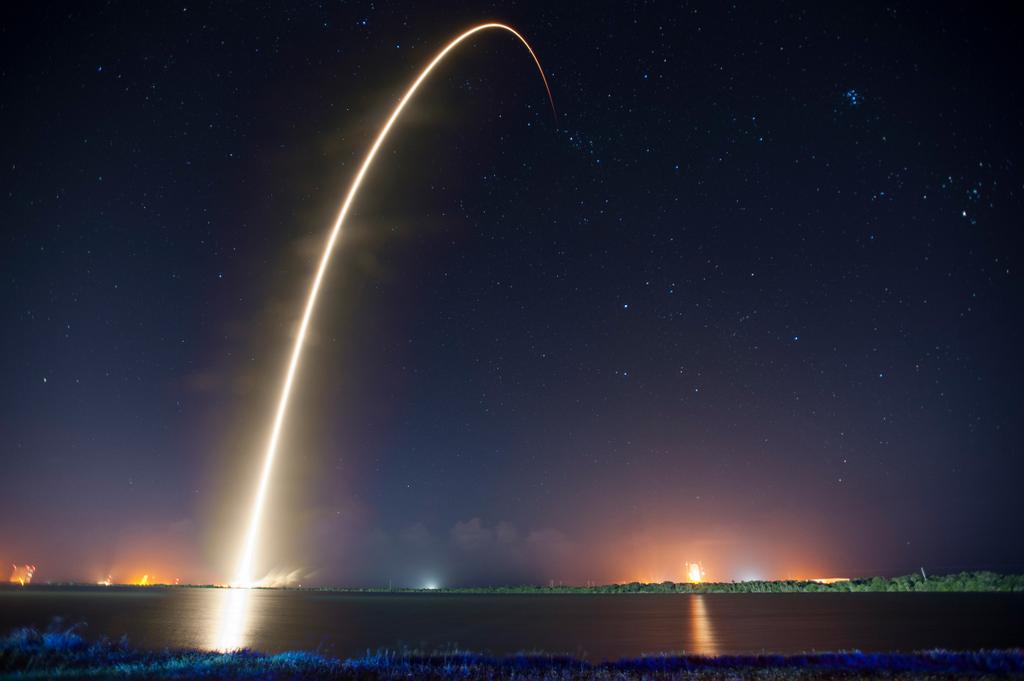
SpaceX's Predawn Rocket Launch Tomorrow May Be Visible Along US East Coast

Hey, space fans! SpaceX is counting down to launch its Dragon spacecraft in the wee hours of Saturday, Jan. 10, and the predawn Falcon 9 rocket liftoff just might be visible to early-bird skywatchers long the U.S. East Coast, weather and local conditions permitting. I've had the luck to see a SpaceX night launch in person, as well as watch from northern New Jersey as rockets launched from Virginia arced across the sky, so I can tell you it's an amazing sigtht to behold, if you can see it.
Here's an afternoon reminder on where to look early Saturday in case you live in a region where you might be able to see the launch: SpaceX plans to launch the Falcon 9/Dragon mission at 4:47 a.m. EST (0947 GMT) from its pad at the Cape Canaveral Air Force Station in Florida. You can watch the SpaceX launch live online starting at 3:30 a.m. EST (0830 GMT), courtesy of NASA TV. And as our skywatching columnist Joe Rao pointed out earlier this week, there is a chance that skywatchers on the Eastern Seaboard could glimpse at least part of the launch after liftoff. You can see his guide here: How to See the SpaceX Launch from the U.S. East Coast.
According to Rao, Saturday's SpaceX launch will travel nearly parallel to the U.S. East Coast as the Falcon 9 rocket makes its way into orbit. So the bright glow from the rocket's nine Merlin first-stage engines could be visible to observers along the coastline, but the degree of visibility depends on location and local weather conditions.
Where You Should Look
According to Rao, the Falcon 9 rocket's glow could be visible to observers anywhere between a few seconds after liftoff to up to 3 minutes into the flight. Here is Rao's guide of when and where to look based on your observing location in order to see the SpaceX.
- Southeast U.S. coastline: For locations north of Cape Canaveral, Florida, viewers should initially concentrate on the south-southwest horizon. If you are south of the Cape in Florida, look low toward the north-northeast. If you're west of the cape, look low toward the east-northeast.
- Mid-Atlantic region: Look to the south about 3 to 6 minutes after liftoff.
- Northeast: Keep your eyes aimed low toward the south-southeast about 6 to 8 minutes after launch.
"Depending upon your distance from the coastline, the SpaceX rocket will be relatively low on the horizon — 5 to 15 degrees. (Your clenched fist held at arm's length covers about 10 degrees of sky.)," Rao wrote in his Monday guide. "If you're positioned near the edge of a viewing circle, the rocket will barely come above the horizon and could be obscured by low clouds or haze."
If you live near the Cape Canaveral area, NASA has compiled a list of local launch viewing areas here.
Editor's note: If you capture a photo of the SpaceX rocket launch from your location on the U.S. East Coast, let us know. You can send images and comments in to managing editor Tariq Malik at: spacephotos@space.com.
Get the Space.com Newsletter
Breaking space news, the latest updates on rocket launches, skywatching events and more!
Email Tariq Malik at tmalik@space.com or follow him @tariqjmalik and Google+. Follow us @Spacedotcom, Facebook and Google+.
Join our Space Forums to keep talking space on the latest missions, night sky and more! And if you have a news tip, correction or comment, let us know at: community@space.com.

Tariq is the Editor-in-Chief of Space.com and joined the team in 2001, first as an intern and staff writer, and later as an editor. He covers human spaceflight, exploration and space science, as well as skywatching and entertainment. He became Space.com's Managing Editor in 2009 and Editor-in-Chief in 2019. Before joining Space.com, Tariq was a staff reporter for The Los Angeles Times covering education and city beats in La Habra, Fullerton and Huntington Beach. In October 2022, Tariq received the Harry Kolcum Award for excellence in space reporting from the National Space Club Florida Committee. He is also an Eagle Scout (yes, he has the Space Exploration merit badge) and went to Space Camp four times as a kid and a fifth time as an adult. He has journalism degrees from the University of Southern California and New York University. You can find Tariq at Space.com and as the co-host to the This Week In Space podcast with space historian Rod Pyle on the TWiT network. To see his latest project, you can follow Tariq on Twitter @tariqjmalik.









